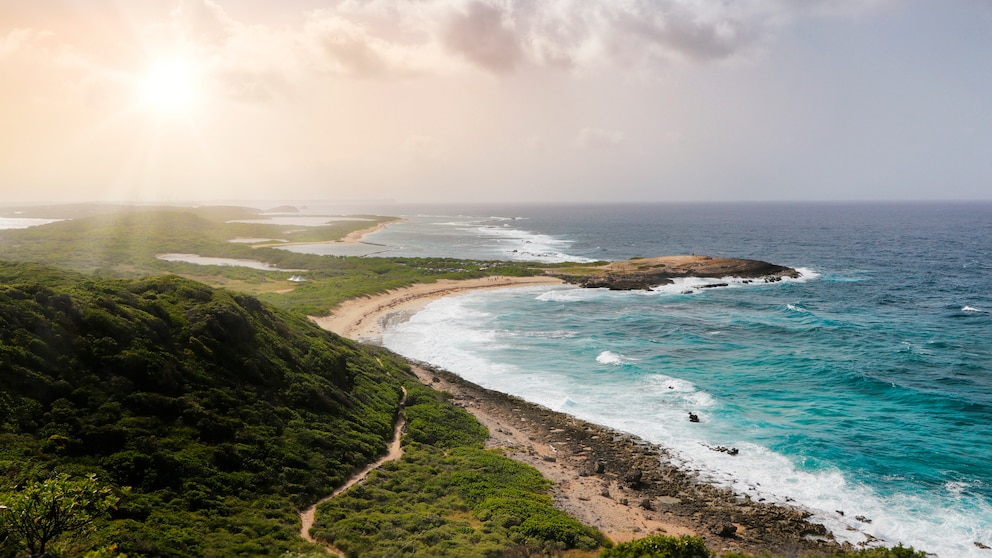December 29, 2024, 5:47 am | Read time: 7 minutes
Many Germans mainly associate a Caribbean vacation with destinations such as Cuba, the Dominican Republic, or the Bahamas. However, there are numerous other island paradises in the Caribbean, such as Guadeloupe. In this overview, TRAVELBOOK provides all the important information on destinations and sights, country data, climate, and more.
Situated approximately 7,000 kilometers from Europe, there’s an archipelago that, while officially part of Europe, scarcely resembles the continent. Guadeloupe is a French overseas department in the Caribbean and, therefore, officially part of the European Union, although not part of the Schengen Area. This Caribbean gem is nestled within the Lesser Antilles, lying north of Dominica and south of Montserrat and Antigua.
It’s a bit of a misnomer to call Guadeloupe “the island”, as this French overseas region is actually an ensemble of two main islands along with several smaller ones. The two largest, Basse-Terre and Grande-Terre, are separated by an arm of the sea that is only around 50 meters wide. But the islands are as different as if they were worlds apart: While Grande-Terre in the east conveys the typical Caribbean feeling with its white dream beaches, charming mills, and sugar cane plantations, Basse-Terre is the island of wild, lush nature and partly black beaches. It is home to the highest mountain in the Lesser Antilles, the 1,467-meter-high volcano La Soufriére, and a national park with waterfalls and hot springs.
The credit for Guadeloupe’s discovery goes to Christopher Columbus, once again. He landed on the island with his fleet in November 1493 and gave it its name—borrowed from the Spanish pilgrimage site of Nuestra Señora de Guadalupe. The first French, mostly farmers, settled on the archipelago in 1635. Since then, Guadeloupe has been French, with brief interruptions. The new inhabitants began cultivating sugar cane and coffee, supported by a number of slaves abducted from Africa. To this day, the majority of the population consists of people with African roots, whose ancestors did not come to the islands voluntarily. Today, museums and other memorials remind us of Guadeloupe’s dark past.
Since 1946, Guadeloupe has shed its colonial status to become an integral part of the French overseas department. This means that the inhabitants are French. Accordingly, the French make up the majority of tourists, but they are not the only ones who are fascinated by the charms of Guadeloupe. Other Europeans relish the convenience of using euros and speaking French in this tropical locale. And many love the tropical paradise even more for its mangroves, waterfalls, volcanoes, giant rubber trees, countless species of orchids, mangoes, as well as papayas, freshwater seals, parrots, hummingbirds, and raccoons—and are delighted that there are no dangerous animals on the Caribbean island. So, welcome to the enchanting Guadeloupe.
Overview
Profile
| Region | Caribbean, Central America |
| Capital city | Basse-Terre |
| Time difference | -5 hours; UTC-4 |
| Area of | 1,628 km² |
| Population | 378.561 |
| Languages | French, Guadeloupe Creole |
| Currencies | Euro (EUR) |
| Visa & entry | German nationals do not require a visa. |
The Top 10 Travel Destinations in Guadeloupe
Guadeloupe has various towns and smaller places on its two main islands and several secondary islands that are popular with tourists. Click through our picture gallery with the top 10 destinations in Guadeloupe.
The Top 10 Sights in Guadeloupe
Beaches, gardens, UNESCO-protected natural sites, old fortresses: Guadeloupe has a number of exciting and beautiful sights that are of interest to tourists. Click through our picture gallery with the top 10 sights in Guadeloupe.
The Top 10 Activities in Guadeloupe
Guadeloupe is a paradise for sailors, surfers, golfers, hikers, and canyoning enthusiasts, and visitors interested in culture will also find what they are looking for. Click through our picture gallery with the top 10 activities in Guadeloupe.
Guadeloupe Map

Overview Dominica: The Most Beautiful Destinations and Best Tips

Overview Bahamas: The Most Beautiful Destinations and Best Tips

Top destination The best travel tips for the Caribbean
Weather and Climate
The climate in Guadeloupe is tropical, with average temperatures between 22 and 30 degrees and high humidity. The Caribbean island state, which belongs to the French overseas department, is one of the “Windward Islands” and is therefore influenced by the northeast trade winds. The hottest months are July and August; the cooler months are January and February. December to June is the dry season in Guadeloupe, with the northeast trade winds blowing constantly. It can sometimes rain during these months too. The best time to travel is from December to April. The rainy season in Guadeloupe is from July to November, when it can sometimes rain heavily, especially in the mountains. In general, there is significantly more rainfall in the west than in the east.
(Text contribution: Silke Böttcher)


